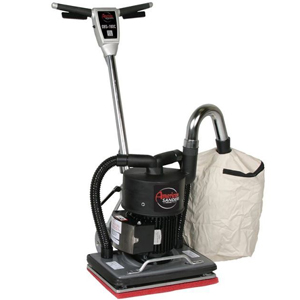The only way to restore your hardwood floor’s original luster is to use a drum sander if it suffers from major problems like deep discoloration, protrusions, grooves, and pits. Edgers, orbital sanders, and drum sanders are the three main types of floor sanders. Floor edgers are essentially large, powerful orbital hand sanders, which are ideal for sanding near baseboards and walls. Even though the orbital floor sander is even larger and more powerful than the edger, both operate by moving a single sheet of sandpaper randomly and rapidly around the wood.
With a drum sander, a loop of sandpaper moves around a drum continuously, ripping down the wood to your desired depth. Since it’s difficult to remove too much wood with an orbital floor sander, it’s hard to make a mistake. A drum floor sander, however, is powerful enough to create grooves that are irreversible or to smooth out major imperfections to restore your floor’s appearance.
- Safety Concerns – The Drum floor sander weighs over 100 pounds, making it an unwieldy machine. If you want to place the sander on your truck bed or in the back of your SUV, you’ll need the assistance of a friend or employee at the rental yard. Remember, too, that you will need assistance with the sander once you get home. If possible, avoid using extension cords when you first get the sander home. If you must use one, you should use only the attached electrical cord or extension cord indicated by the manufacturer for that particular drum sander. An improperly sized extension cord can melt a drum floor sander, causing an electrical fire.
- Renting A Drum Sander – The drum floor sander is a piece of equipment you never want to own. Drum sanders can cost thousands of dollars, and they can only be used to sand hardwood floors. Drum floor sanders are usually available at rental yards and home centers with rental components.
- Make Sure You Have Enough Sandpaper – The grit of sandpaper determines how rough it is. You should purchase a range of grits at the time of rental and more than you think you will need. With a drum sander, you will be buying long strips of sandpaper that cannot be used for any other purpose. Most rental yards will accept unused and clean sandpaper back as long as the user buys more than is actually required. We recommend purchasing a large quantity of sandpaper so as not to run out while your floor sander is on the rental clock. Running down to the rental yard for more sandpaper takes up valuable rental time.
- Wear Safety Equipment – Unless you have a preference for working without safety equipment, floor sanding is not for you. It is important to note that even though the drum sander comes with a dust bag, the bag only captures a majority of dust, not all of it. You should also wear safety glasses. The drum floor sanders produce sparks when they hit nails, and they can shoot particles nearly as fast as a bullet.
- Pay Attention to What You’re Doing – The use of paintbrushes and bubble levels is safe and benign. The power and ability of other tools, such as table saws and powder-actuated nailers, to cause destruction and injury deserve our utmost respect and care. A floor drum sander falls into this category. Drum sanders are often used by flooring professionals to artificially distress floor planks, which indicates their potential for destroying floors beyond repair. Drum sanders can leave massive gouges if left in one place for too long. Failure to follow safety precautions can result in serious injury.
- The Sander Moves Opposite to the Sanding Direction – Instead of pushing, you will pull the drum floor sander. Basically, you are moving the sander the other way from how you would move a drum. Try not to get close to trim, baseboards, doors, walls, or anything else that cannot be sanded. Drum sanders can damage these items, either from the moving drum or by hitting them with the machine’s housing.
- Sand Lightly Along The Grain – You should only use the weight of the sander when running it. Extra pressure is not necessary. Pull the drum sander along the grain of the wood, overlapping each line like you would when mowing the lawn. Take frequent breaks to rest your arms and empty the dust bag.







